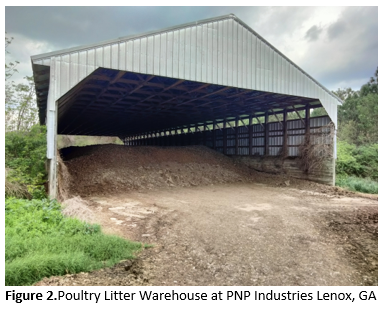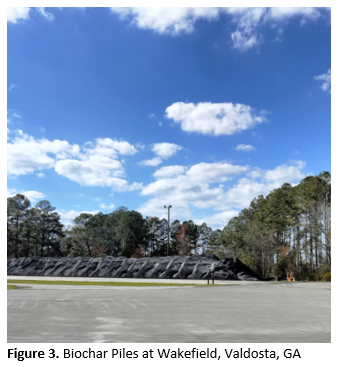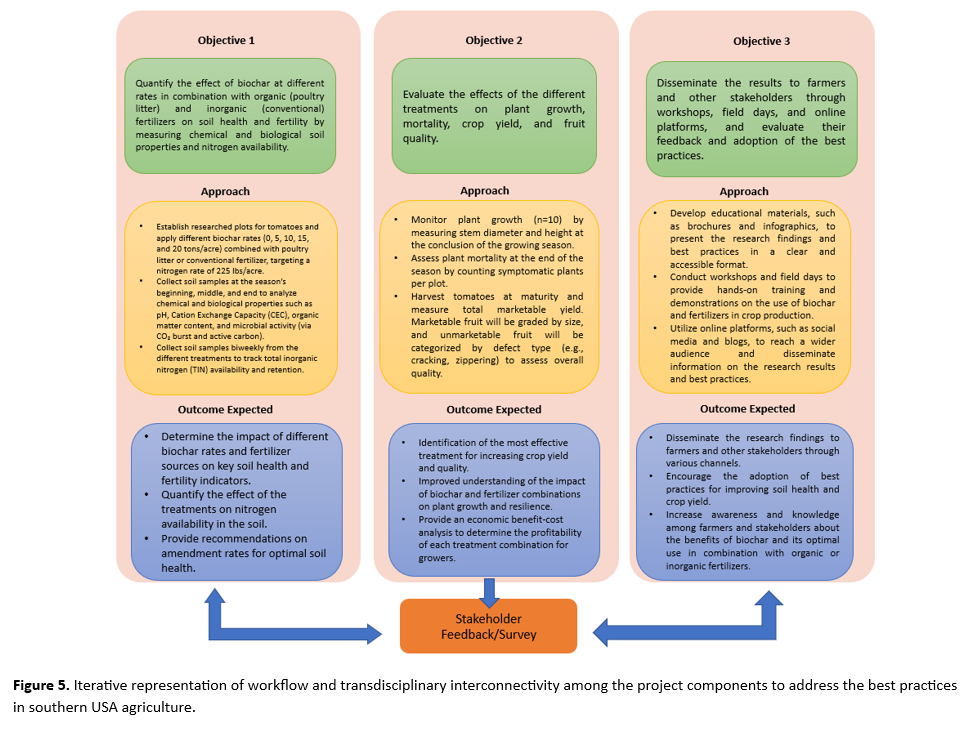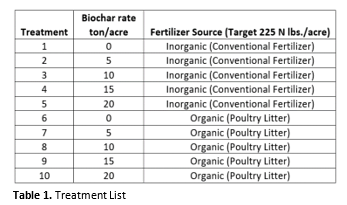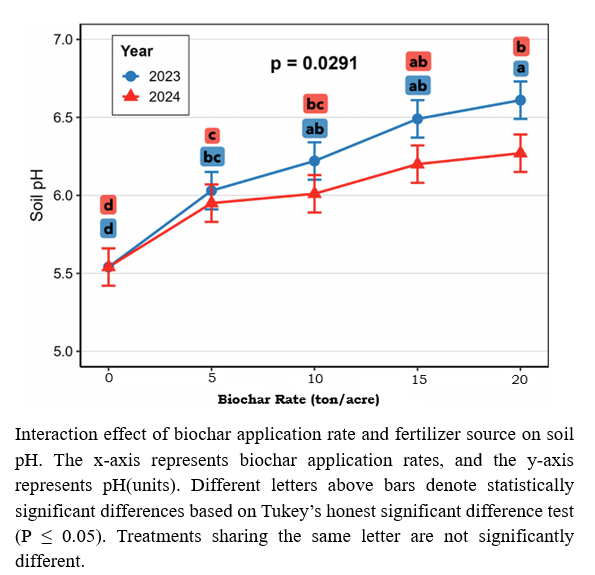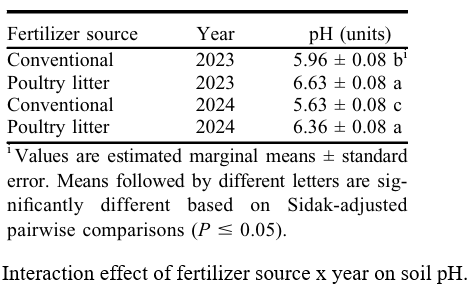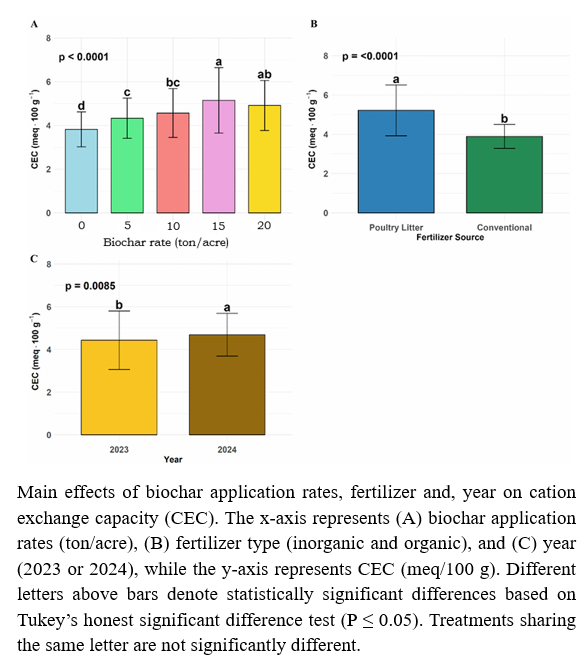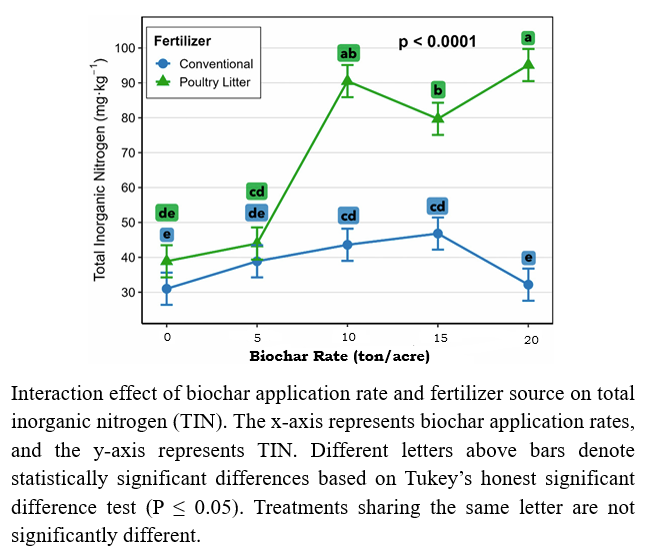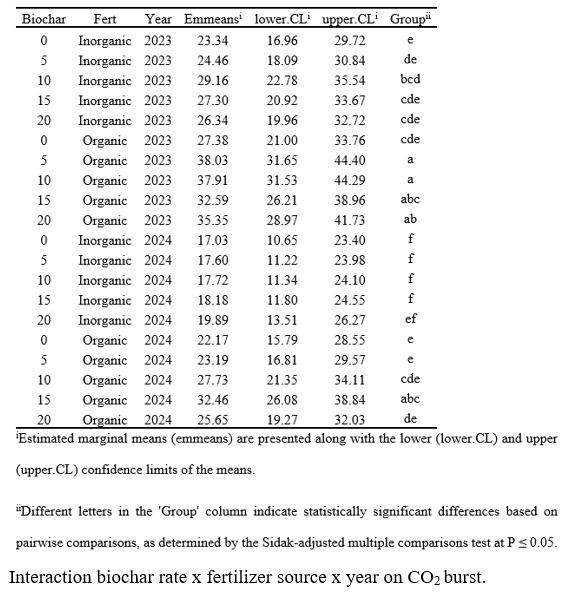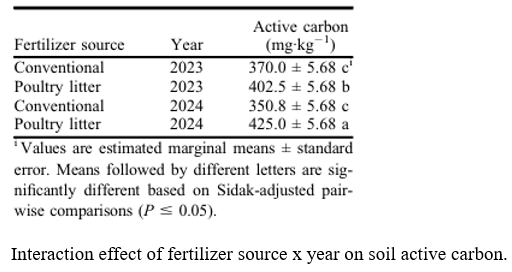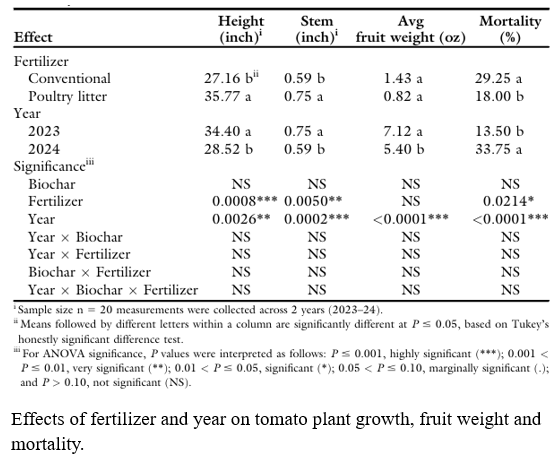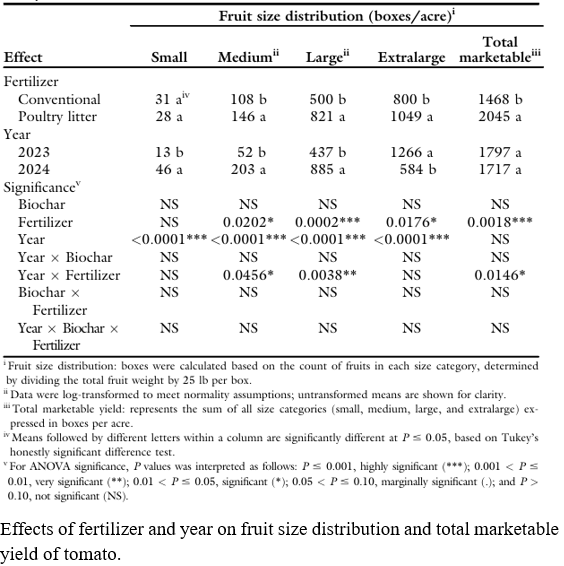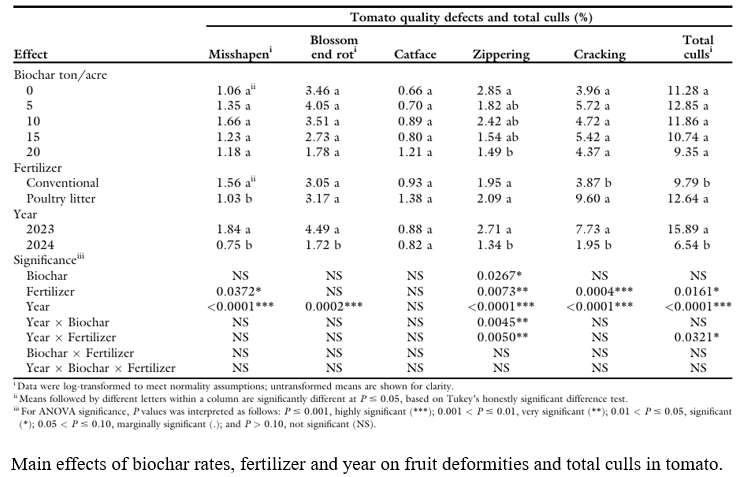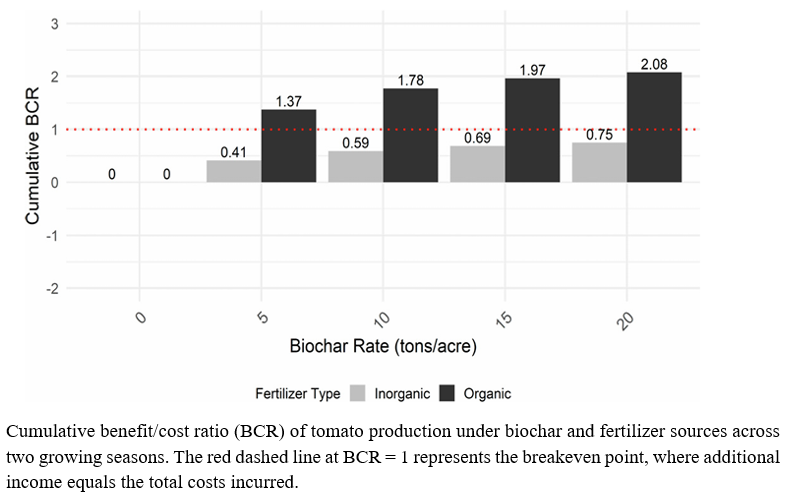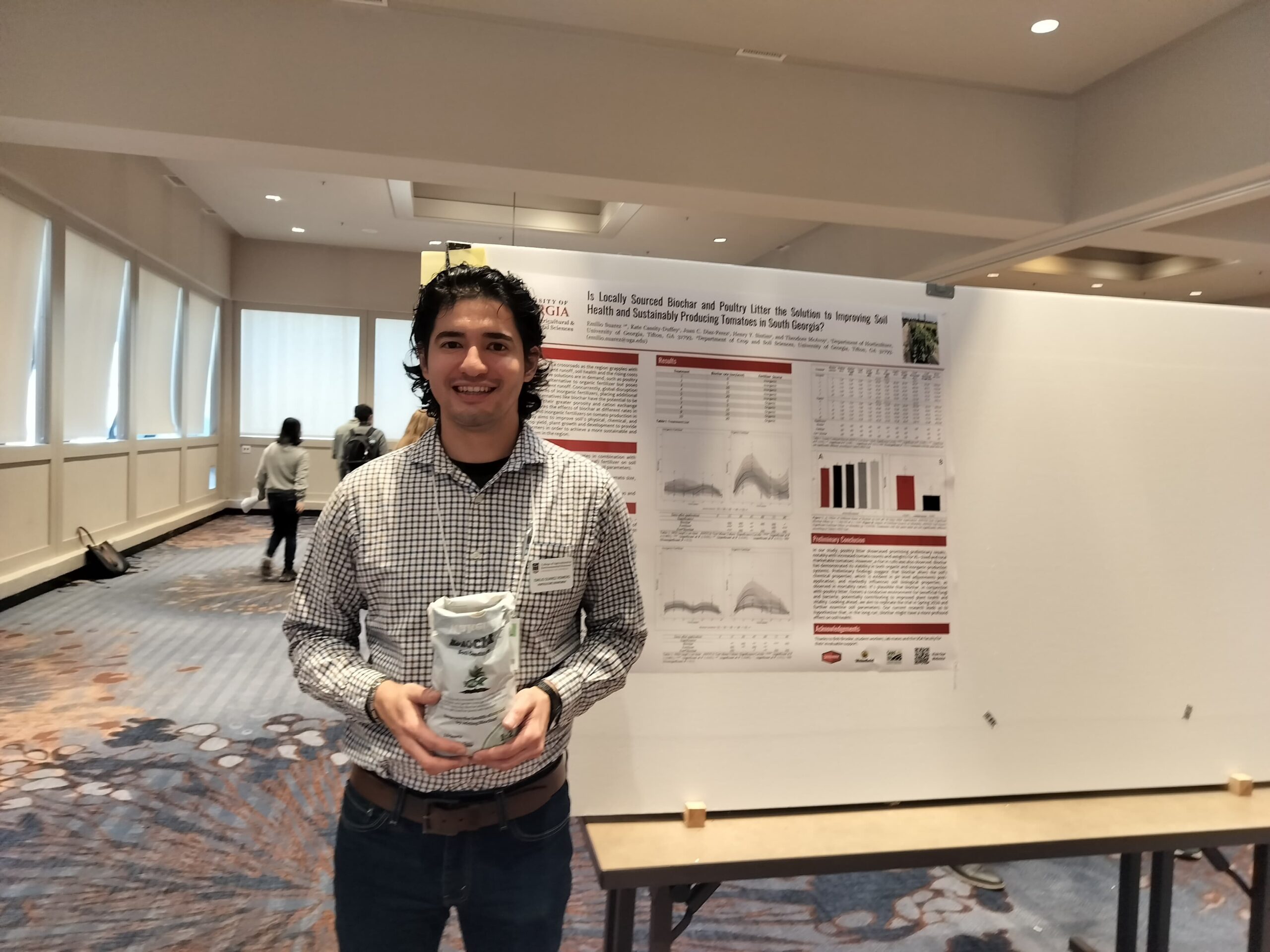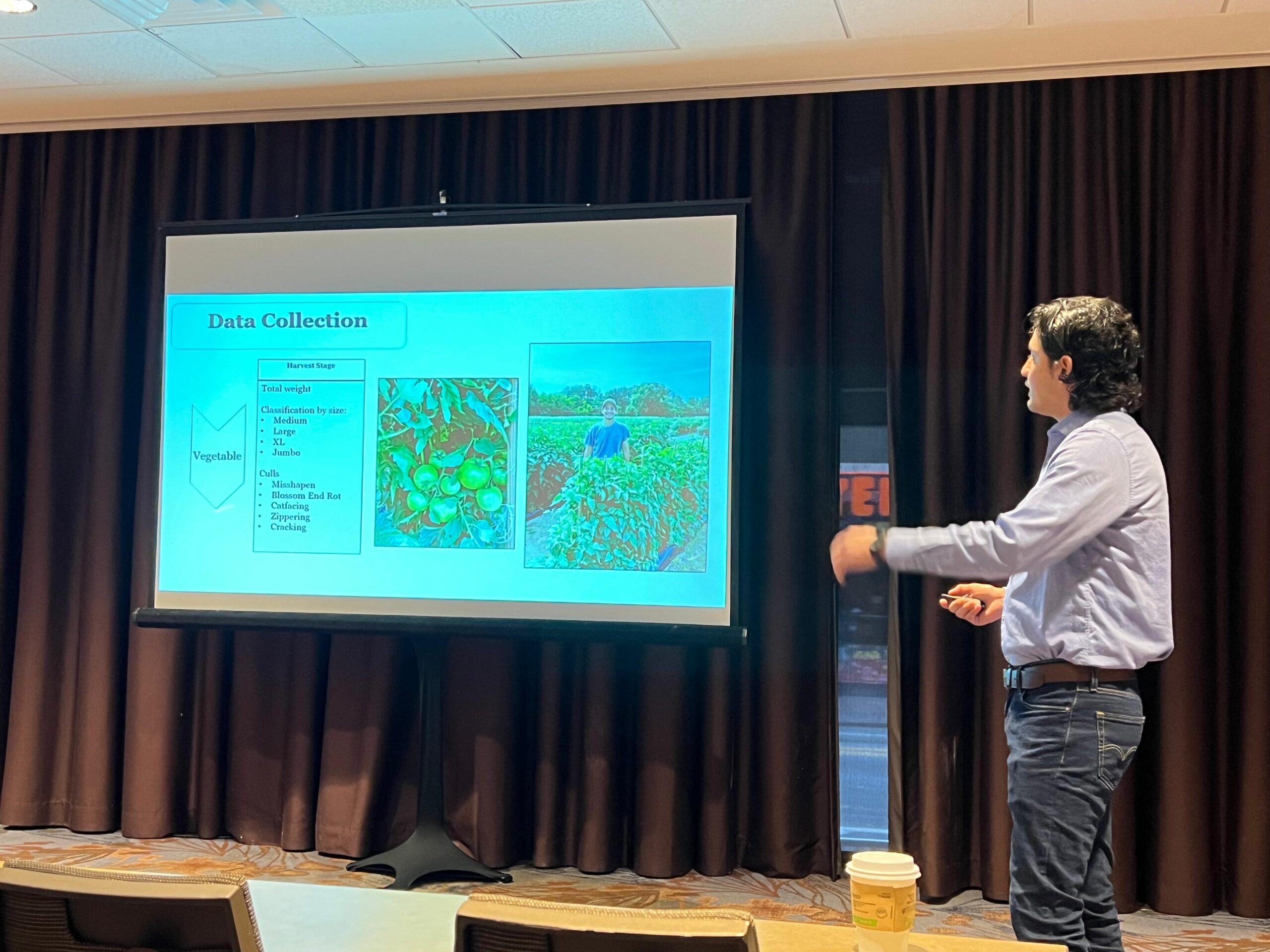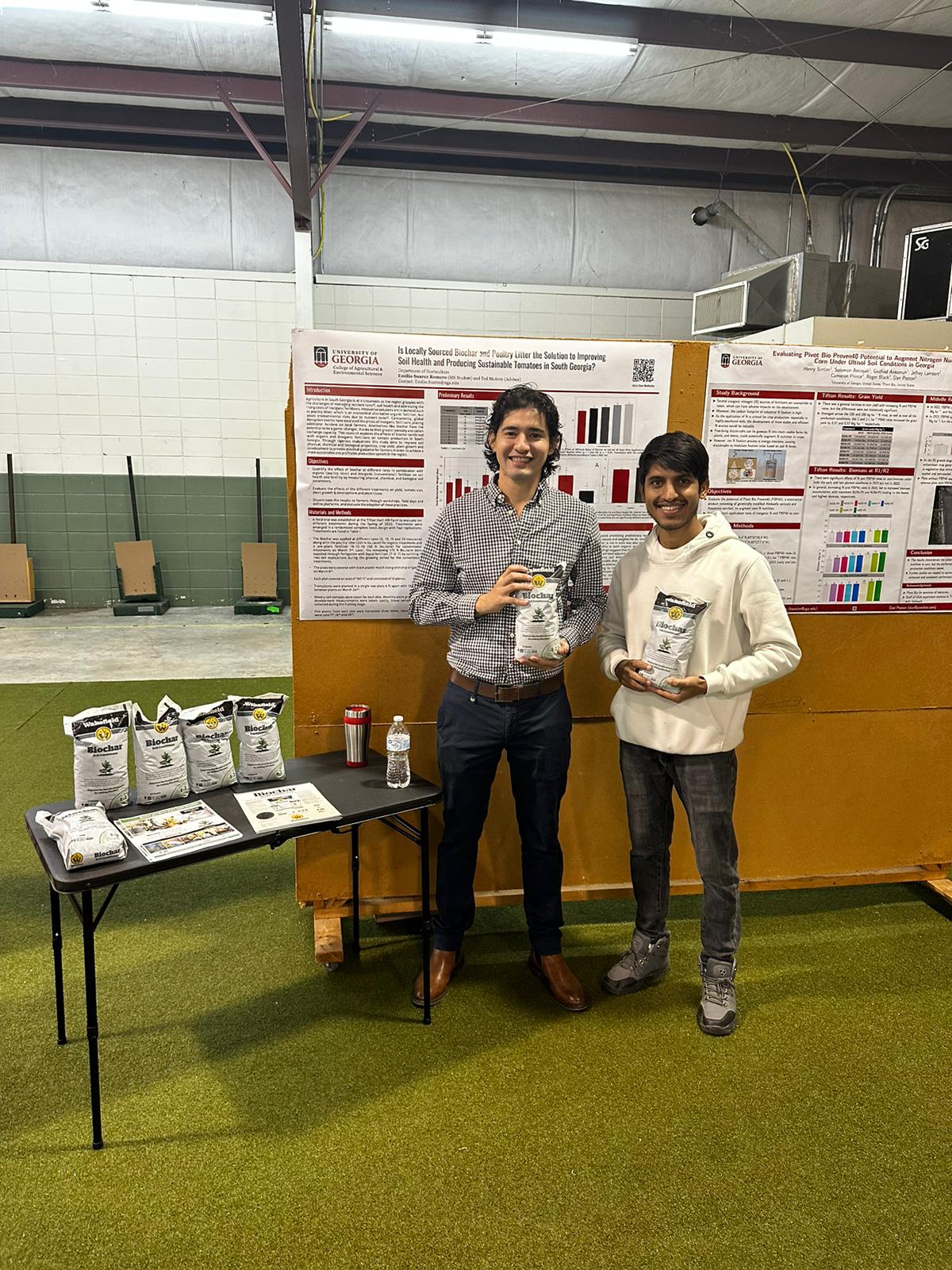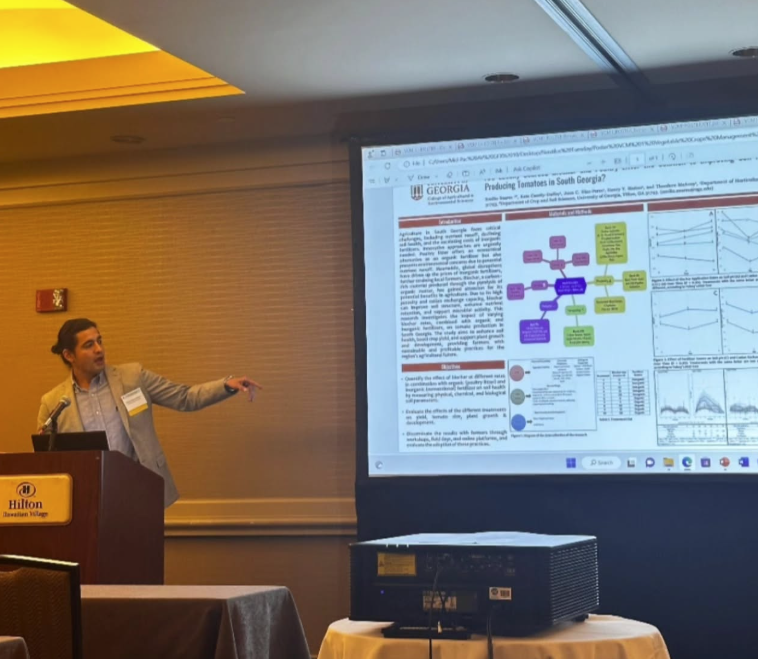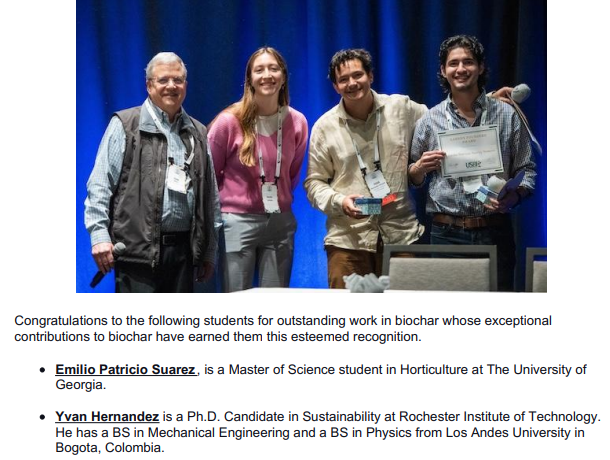Final report for GS23-275
Project Information
This project aims to assess the effectiveness of biochar, a type of charcoal produced through pyrolysis, on soil health and crop productivity in South Georgia. The study will use biochar at different rates (0, 5, 10, 15, and 20 tons/acre) in combination with organic (poultry litter) or inorganic (conventional) fertilizers. The objective is to quantify the effect of these treatments on soil health and yield using standardized monitoring protocols. The study will also analyze the impact on plant growth, including plant height and stem diameter, as well as tomato fruit yield and quality, and the microbial activity of the soil.
By combining biochar with poultry litter, it is hypothesized that biochar will enhance nutrient retention, thereby reducing nutrient runoff. Additionally, the presence of biochar may also reduce the negative environmental impacts associated with poultry litter alone. The project will evaluate the effects of the amendments on soil chemical and biological properties, including pH, organic matter content, microbial activity, nutrient availability and retention in the soil, and potential for toxic metal accumulation.
The project utilizes locally sourced byproducts, including biochar from pine forestry byproducts and poultry litter from Georgia's broiler production. A key component of this project is an economic benefit-cost analysis to determine the profitability of these practices for growers. The findings from this research will be shared with farmers to enhance best practices, improve crop management, and address environmental challenges. The results are expected to contribute to the sustainability of southern agriculture by improving profitability, sustaining ecological quality, and enhancing the quality of life for farmers and rural communities.
Objective 1
Quantify the effect of biochar at different rates in combination with organic (poultry litter) and inorganic (conventional) fertilizers on soil health and fertility by measuring chemical and biological soil properties and nitrogen availability.
Approach
-
Establish researched plots for tomatoes and apply different biochar rates (0, 5, 10, 15, and 20 tons/acre) combined with poultry litter or conventional fertilizer, targeting a nitrogen rate of 225 lbs/acre.
-
Collect soil samples at the season’s beginning, middle, and end to analyze chemical and biological properties such as pH, Cation Exchange Capacity (CEC), organic matter content, and microbial activity (via CO₂ burst and active carbon).
-
Collect soil samples biweekly from the different treatments to track total inorganic nitrogen (TIN) availability and retention.
Outcome Expected
-
Determine the impact of different biochar rates and fertilizer sources on key soil health and fertility indicators.
-
Quantify the effect of the treatments on nitrogen availability in the soil.
-
Provide recommendations on amendment rates for optimal soil health.
Objective 2
Evaluate the effects of the different treatments on plant growth, mortality, crop yield, and fruit quality.
Approach
- Monitor plant growth (n=10) by measuring stem diameter and height at the conclusion of the growing season.
- Assess plant mortality at the end of the season by counting symptomatic plants per plot.
- Harvest tomatoes at maturity and measure total marketable yield. Marketable fruit will be graded by size, and unmarketable fruit will be categorized by defect type (e.g., cracking, zippering) to assess overall quality.
Outcome Expected
-
Identification of the most effective treatment for increasing crop yield and quality.
-
Improved understanding of the impact of biochar and fertilizer combinations on plant growth and resilience.
-
Provide an economic benefit-cost analysis to determine the profitability of each treatment combination for growers.
Objective 3
Disseminate the results to farmers and other stakeholders through workshops, field days, and online platforms, and evaluate their feedback and adoption of the best practices.
Approach
-
Develop educational materials, such as brochures and infographics, to present the research findings and best practices in a clear and accessible format.
-
Conduct workshops and field days to provide hands-on training and demonstrations on the use of biochar and fertilizers in crop production.
-
Utilize online platforms, such as social media and blogs, to reach a wider audience and disseminate information on the research results and best practices.
Outcome Expected
-
Disseminate the research findings to farmers and other stakeholders through various channels.
-
Encourage the adoption of best practices for improving soil health and crop yield.
-
Increase awareness and knowledge among farmers and stakeholders about the benefits of biochar and its optimal use in combination with organic or inorganic fertilizers.
Cooperators
- (Researcher)
- (Researcher)
- (Researcher)
Research
Experimental Design and Treatments
This research will be conducted over two spring growing seasons at the University of Georgia's Tifton Campus Hort Hill Farm, located in the Coastal Plain region of South Georgia. The soil texture is sandy loam, typical for the area, characterized by low organic matter and acidic pH.
The experiment will be structured as a 5 x 2 factorial in a randomized complete block design (RCBD) with four replications.
The two factors are:
-
Biochar Rate: Five application rates of 0, 5, 10, 15, and 20 tons/acre. The biochar, sourced from pine wood chips, will be applied once as a surface amendment and incorporated prior to the first growing season.
-
Fertilizer Source: Two fertilizer programs, conventional (inorganic) or poultry litter (organic).
Each experimental plot will measure 6 ft wide by 30 ft long, with a 5-ft alley between blocks to prevent cross-contamination. Tomato seedlings ('Summer Heaven F1') will be transplanted in single rows with 18 inches between plants. Each plot, containing 10 plants, will serve as one experimental unit. A standard stake-and-weave trellis system will be used, and irrigation will be supplied via drip tape under totally impermeable film (TIF) plastic mulch.
The target nitrogen (N) rate for all treatments is 225 lbs N/acre, based on UGA Extension recommendations for tomato production.
-
Conventional Treatment: This will involve a pre-plant granular fertilizer application providing 50 lbs N/acre. The remaining 175 lbs N/acre will be supplied in 10 weekly fertigation events through the drip system.
-
Poultry Litter Treatment: Locally sourced broiler litter will be analyzed for N content prior to application. The full 225 lbs N/acre rate will be applied and incorporated pre-plant, adhering to the USDA 90-day pre-harvest interval for raw manure application.
The first objective is to quantify the effect of biochar, combined with organic and inorganic fertilizers, on soil health and fertility by measuring physical, chemical, and biological soil parameters and nitrogen mineralization in the field. To achieve this, individual research fields will be established for tomatoes and apply different biochar rates (0, 5, 10, 15, and 20 tons/acre) combined with poultry litter or conventional fertilizer (Table.1).
Objective 1: Soil Health and Fertility Analysis
To quantify the effects of the treatments on soil health, a systematic soil sampling and analysis protocol will be followed.
-
Sampling Schedule: Soil core samples (0-6 inches depth) will be collected from each plot. Samples for nitrogen analysis will be collected biweekly, while samples for all other chemical and biological analyses will be collected every 30 days throughout the growing season.
-
Chemical Analysis: Samples will be analyzed for soil pH, Cation Exchange Capacity (CEC), and total inorganic nitrogen (TIN) by measuring nitrate (NO3−) and ammonium (NH4+) concentrations.
-
Biological Analysis: To assess soil biological health, samples will be analyzed for organic matter content, active carbon, and microbial activity (via the Solvita CO2 Burst Method).
Objective 2: Crop Growth, Yield, and Quality Analysis
To evaluate the impact on the tomato crop, detailed measurements of plant growth and fruit production will be recorded.
-
Plant Growth and Mortality: Plant height and stem diameter will be measured for all 10 plants in each plot at the end of the final harvest. Plant mortality will also be assessed at the end of the season by counting dead or wilted plants in each plot.
-
Harvest and Yield Analysis: Tomatoes will be harvested multiple times as they reach the breaker stage. Fruit from the center five plants of each plot will be used for yield data collection. Harvested fruit will be separated into marketable and unmarketable categories.
-
Fruit Quality Assessment: A mechanical grader will be used to sort marketable fruit into USDA size categories (small, medium, large, and extra-large). Unmarketable fruit will be counted and categorized by the type of defect (e.g., zippering, cracking, blossom end rot, misshapen) to provide a detailed assessment of fruit quality.
Objective 3: Dissemination of Results
The third objective is to disseminate the results to farmers and other stakeholders through workshops, field days, and online platforms. To achieve this, educational materials, such as brochures and infographics, will be created in a clear and accessible format. In partnership with UGA Extension, workshops and field days will be coordinated to provide hands-on training on using these soil amendments. In addition, online platforms, such as social media and webinars, will be used to reach a wider audience. The expected outcome is to disseminate the research findings, encourage the adoption of best practices, and increase awareness among stakeholders about the benefits of biochar in combination with organic or inorganic fertilizers.
Results and Discussion
The project successfully demonstrated that amending Coastal Plain soils with biochar and poultry litter significantly improved soil health, crop performance, and economic viability compared to conventional fertilizer systems. The findings are discussed below.
Soil Chemical and Biological Properties
The soil analysis confirmed that the amendments created a more fertile and biologically active environment for crop growth.
- Soil pH and CEC: Soil pH was significantly influenced by two key interactions: the interaction between biochar rate and year, and the interaction between fertilizer source and year.
-
-
-
Biochar Rate × Year Interaction: Increasing biochar rates raised soil pH in both years, but the effect was more pronounced in the first year. In 2023, the highest biochar rate increased soil pH by 1.07 units (from 5.54 to 6.61), while in 2024 the increase was 0.73 units (from 5.54 to 6.27).
-
Fertilizer Source × Year Interaction: Poultry litter treatments consistently resulted in a higher soil pH than conventional fertilizer treatments in both years. Importantly, while the pH in conventional plots significantly decreased from 2023 to 2024, the pH in poultry litter plots remained statistically stable, demonstrating the superior buffering capacity of the organic amendment.
- Following these pH changes, the Cation Exchange Capacity (CEC), a measure of soil fertility, also increased by up to 34.8% with higher biochar rates. Poultry litter treatments also yielded a 34.1% higher CEC than conventional fertilizer
-
-
Nitrogen Retention: A key finding was the enhanced retention of soil nitrogen. There was a strong synergistic effect between biochar and poultry litter. In treatments with poultry litter, Total Inorganic Nitrogen (TIN) increased steadily with biochar application, achieving a 144.7% gain at the highest rate compared to the control. In contrast, under conventional fertilizer, TIN levels peaked at a moderate biochar rate and then declined. This shows that the biochar-poultry litter combination was far more effective at holding nitrogen in the root zone.
Biological Activity: The biological health of the soil was driven by significant and complex interactions involving the amendments and environmental conditions across the two years.
-
Microbial Activity (CO₂ Burst): A significant three-way interaction showed that microbial activity was substantially higher in 2023 than in 2024 across most treatments. In 2023, poultry litter combined with biochar significantly stimulated microbial respiration compared to the control. Under conventional fertilizer, microbial activity was consistently lower and showed little response to biochar, especially in 2024.
-
Active Carbon: A significant Fertilizer Source × Year interaction revealed a diverging trend in the soil's readily available carbon pool. Under poultry litter, active carbon increased by 5.6% from 2023 to 2024, showing a cumulative benefit. Conversely, under conventional fertilizer, active carbon declined by 5.2% over the same period, indicating a depletion of this vital soil health component.
-
Organic Matter: Soil organic matter showed a similar interaction. With poultry litter, organic matter increased by 4.5% from the first year to the second. With conventional fertilizer, however, organic matter slightly declined. This demonstrates that the poultry litter treatments were actively building soil organic matter over time, while the conventional system was not.
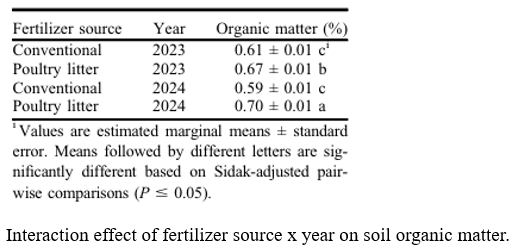
Crop Performance: Growth, Yield, and Quality
The improvements in soil health translated directly into better plant performance and higher yields, with poultry litter having the most significant agronomic impact.
-
Plant Growth and Resilience: Plants grown with poultry litter were significantly more vigorous. They were, on average, 32% taller and had 27% larger stem diameters than plants grown with conventional fertilizer. Crucially, poultry litter treatments conferred greater resilience to disease; plant mortality was significantly lower in these plots compared to the much higher mortality (63% higher) observed in the conventional fertilizer plots.
-
Marketable Yield: The most critical production metric, marketable yield, was 39% higher in poultry litter treatments than in conventional treatments. In contrast, biochar application by itself had no significant effect on total marketable yield in either growing season.
Fruit Quality: While poultry litter drove yield, biochar's most notable direct impact was on fruit quality. Higher biochar application rates (15-20 tons/acre) significantly reduced the incidence of the physiological disorder "zippering" by up to 47% compared to the control treatment. This shows that biochar adds value by increasing the percentage of high-quality, marketable fruit. Zippering is caused by anthers adhering to the ovary wall during early fruit development and is often linked to environmental stress, especially fluctuations in water availability. Because biochar is known to enhance soil water retention and stabilize moisture, it is plausible that this property helped mitigate the water stress that can lead to zippering.
Economic Viability and Grower Recommendations
The economic analysis provided a clear and compelling case for the adoption of these sustainable practices.
The Benefit-Cost Ratio (BCR) analysis revealed that combining poultry litter with high rates of biochar was highly profitable. The most profitable treatment (20 tons/acre biochar + poultry litter) achieved a cumulative BCR of 2.08, meaning the additional income was more than double the cost of the amendments. In stark contrast, all conventional fertilizer treatments remained below the economic viability threshold (BCR < 1.0), failing to generate enough additional income to offset their costs.
These results form the basis of our primary recommendation: integrating locally sourced poultry litter and high rates of biochar is a profitable and sustainable strategy for tomato growers in the southeastern U.S. to improve soil health and long-term productivity.
Educational & Outreach Activities
Participation summary:
The findings from this project were widely disseminated to academic, industry, and grower audiences through a multi-faceted education and outreach program. The activities included peer-reviewed publications, presentations at scientific conferences, and direct engagement with the local agricultural community.
Peer-Reviewed Publications
The primary scientific outreach was accomplished through the publication of the project's results in two high-impact horticultural journals:
-
Suarez, E., Diaz-Perez, J. C., & Pulici, E., et al. (2025). Biochar Rate and Fertilizer Source Influence Soil Chemical and Biological Properties in Tomato Plasticulture Systems. HortScience, 60(9), 1432-1440.
-
Suarez, E., Diaz-Perez, J. C., & Acharya, N., et al. (2025). Biochar Rate and Fertilizer Source Influence Tomato Growth, Mortality, Yield, and Profitability. HortTechnology, 35(4), 574-583.
Conference Presentations
The principal investigator delivered the project's findings at nine different events, including four poster sessions and five oral presentations. These presentations reached a diverse audience at local, regional, national, and international venues.
-
National/International: Presentations were given at the Annual American Society for Horticultural Science (ASHS) Conference in Honolulu, HI, and the National Biochar Conference in Sacramento, CA.
-
Regional/Local: Findings were also shared at the Southern Region ASHS meeting in Atlanta, GA, and with the local community at World Soils Day in Tifton, GA.
Notably, these presentations received significant recognition, earning first place in the poster competition at World Soils Day and second place at the annual ASHS conference.
Poster Presentations
- Suarez, E., Cassity-Duffey, K., Diaz-Perez, J.C., Sintim, H.Y., McAvoy, T. (2024, February). Are Locally Sourced Biochar and Poultry Litter the Solution to Improving Soil Health and Sustainably Producing Tomatoes in South Georgia? Poster session presentation at the Annual American Society for Horticultural Science (ASHS) Conference, Vegetable Crops Management Session, Honolulu, HI.
- Suarez, E., Cassity-Duffey, K., Diaz-Perez, J.C., Sintim, H.Y., Yu, P., McAvoy, T. (2024, February). Local Biochar and Poultry Litter: Key to Sustainable Soil Health and Tomato Growth in South Georgia. Poster session presented at the National Biochar Conference, Sacramento, CA.
- Suarez, E., Cassity-Duffey, K., Diaz-Perez, J.C., Sintim, H.Y., McAvoy, T. (2024, February). Is Locally Sourced Biochar and Poultry Litter the Solution to Improving Soil Health and Sustainably Producing Tomatoes in South Georgia? Poster session presented at the Southern Region American Society for Horticultural Science, Atlanta, GA.
- Suarez, E., Cassity-Duffey, K., Diaz-Perez, J.C., Sintim, H.Y., McAvoy, T. (2023, December). Is Locally Sourced Biochar and Poultry Litter the Solution to Improving Soil Health and Sustainably Producing Tomatoes in South Georgia? Poster session presented at World Soils Day, Tift County Ag Service Center, Tifton, GA.
Oral Presentations
- Suarez, E. & McAvoy, T. (2025, April). Biochar: A Carbon Solution for Tomorrow. Special Guest Seminar Series, University of Tennessee, Knoxville
- Suarez, E., McAvoy, T. (2025, March).Biochar: New Gold for Sustainability? Presentation at Horticulture Graduate Student Exchange Program Competition, Athens, GA.
- Suarez, E., McAvoy, T. (2024, September). Waste to Wealth: Supercharging Soil with Biochar. Presentation at the Scholar Ignite (3 Minute Competition), Annual American Society for Horticultural Science (ASHS) Conference, Honolulu, HI.
- Suarez, E., Cassity-Duffey, K., Diaz-Perez, J.C., Sintim, H.Y., McAvoy, T. (2024, September). Boosting Sweet Corn Yields: The Power of Biochar and Fertilizers Unveiled. Oral presentation at the Annual American Society for Horticultural Science (ASHS) Conference, Vegetable Crops Management Session, Honolulu, HI.
- Suarez, E., Cassity-Duffey, K., Diaz-Perez, J.C., Sintim, H.Y., McAvoy, T. (2024, February). Is Locally Sourced Biochar and Poultry Litter the Solution to Improving Soil Health and Sustainably Producing Tomatoes in South Georgia? Oral presentation at the Southern Region American Society for Horticultural Science, Vegetable Symposium, Atlanta, GA.
Special Award
Larson Founder's Award. Feb, 2024. at the National Biochar Conference, Sacramento, CA.
The Larson Founders Award is a scholarship honoring the remarkable achievements and dedication of students in the biochar field. This scholarship provides complimentary registration to the North American Biochar Conference, enabling student recipients to enrich their understanding, create meaningful connections, and contribute to the advancement of the industry.
https://biochar-us.org/sites/default/files/blog/US_Biochar_Initiative-February_2024-Newsletter.pdf
Grower and Community Engagement
Direct engagement with growers and stakeholders was a key component of the project's outreach.
-
Field Day: A vegetable field day was held at the UGA Tifton Campus on June 3rd, 2024, to provide a hands-on demonstration of the research plots. The event was attended by approximately 26 local farmers, who engaged in discussions about the practical applications of using biochar and poultry litter in tomato production.
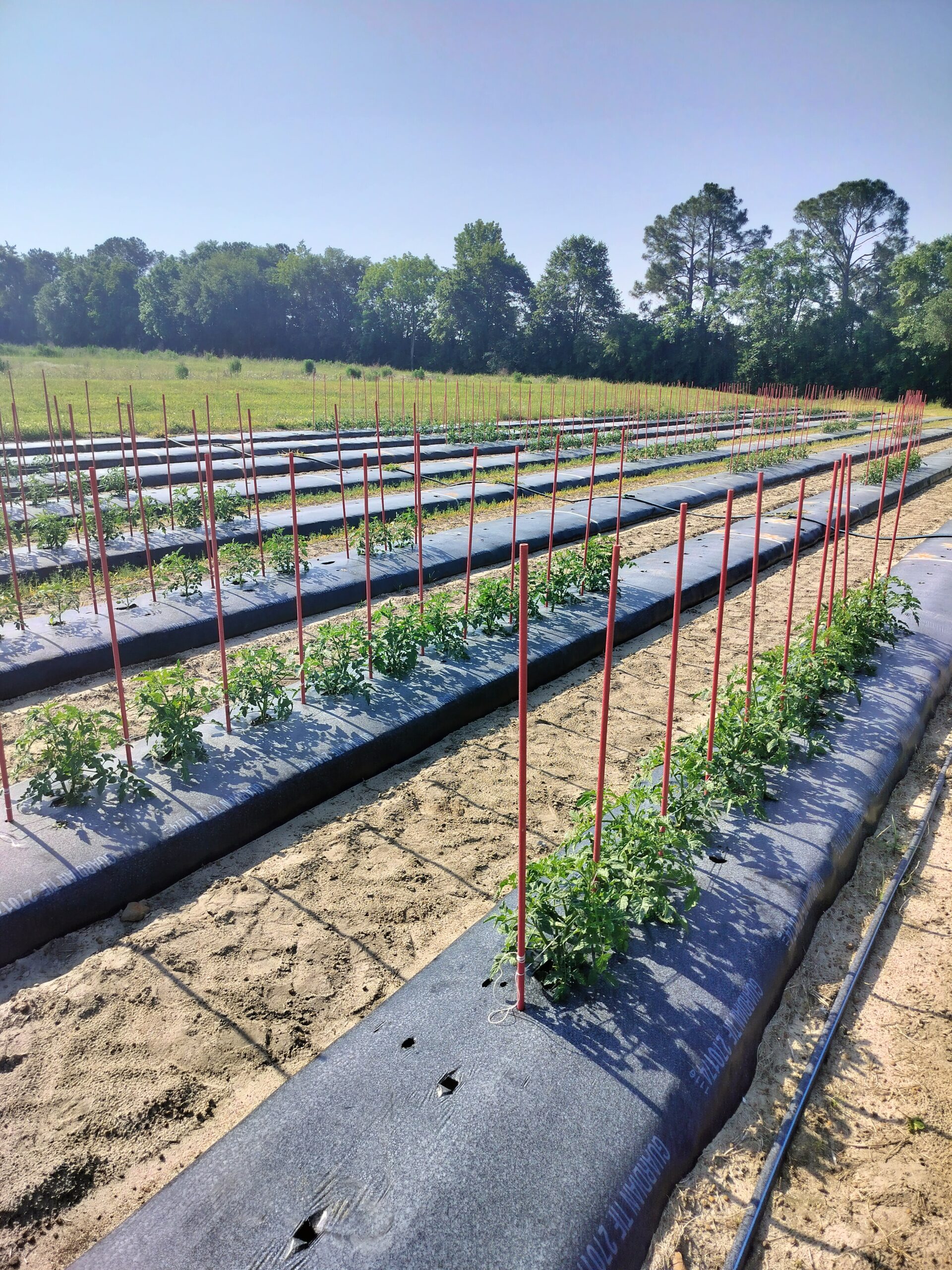
Project Outcomes
This project successfully demonstrated that an integrated system using biochar and poultry litter can enhance agricultural sustainability in South Georgia. The key outcomes are detailed below.
Economic Benefits
-
Demonstrated Profitability: The most significant economic outcome was the clear demonstration of profitability. The integrated system of poultry litter and biochar was highly profitable, achieving a cumulative benefit-cost ratio (BCR) greater than 2.0 at higher application rates. In stark contrast, all treatments using conventional fertilizer with biochar remained below the economic viability threshold (BCR < 1.0).
-
Increased Crop Productivity: The profitability of the organic-based system was driven by a 39% increase in total marketable yield compared to the conventional fertilizer system. This shows that sustainable practices can directly lead to higher income for farmers.
-
Long-Term Soil Health Investment: The project showed that the poultry litter treatments led to a cumulative increase in soil organic matter and active carbon over the two-year period, while the conventional system did not. This represents a long-term investment in soil capital that can sustain productivity and potentially reduce future input costs.
Environmental Benefits
-
Improved Nutrient Retention: The project provided strong evidence for reduced nutrient loss potential. The combination of biochar and poultry litter increased the retention of total inorganic nitrogen in the soil by over 140% compared to the control. This is a critical environmental benefit, as it helps keep nitrogen in the field for crop use and out of adjacent water bodies.
-
Carbon Sequestration: By applying a stable, carbon-rich material to the soil, this project utilized a direct method for carbon sequestration. This practice contributes to mitigating climate change by locking atmospheric carbon into the soil for long periods.
-
Reduced Reliance on Synthetic Fertilizers: This research validated a system that is both more productive and more profitable than the conventional fertilizer system it was compared against. This provides a viable pathway for growers to reduce their reliance on synthetic fertilizers, thereby lessening the overall environmental footprint of their operations.
Social Benefits
-
Enhanced Local Food Availability: By increasing marketable tomato yields significantly, this system contributes directly to the local food supply and enhances regional food security.
-
Increased Sustainability Awareness: The project's findings were actively disseminated to a wide range of audiences through nine scientific presentations, two peer-reviewed publications, and a grower field day attended by approximately 26 local farmers. This extensive outreach program has increased awareness and knowledge of these sustainable practices within both the scientific and farming communities.
-
Improved Quality of Life for Farmers: By providing a clear, evidence-based pathway to increase profitability while improving environmental stewardship, this project addresses key stressors in the farming profession. A system that is both economically resilient and environmentally sound improves the long-term viability and quality of life for farmers and rural communities.
This project fundamentally shifted our perspective on sustainable agriculture, moving us from a theoretical belief in individual amendments to a practical understanding of integrated, synergistic systems.
Initially, our approach was guided by the widespread hypothesis that biochar is a universally beneficial amendment for improving soil health and yield. However, our direct experience led to a crucial shift in awareness: we learned that the context of the farming system is paramount. The most critical lesson was realizing that biochar's role is not as a primary driver of yield, but as a powerful synergist that unlocks the potential of other inputs, particularly organic amendments. Our knowledge evolved from viewing amendments in isolation to appreciating their complex interactions. We now have a deeper understanding of how poultry litter drives the primary biological and agronomic outcomes, while biochar provides crucial chemical stability (improving pH) and targeted benefits (improving fruit quality).
Our skills in experimental design and statistical analysis were sharpened, particularly in interpreting the complex, multi-year interaction effects that revealed the true dynamics of the soil system over time. Beyond this technical expertise, the project honed crucial soft skills in project management, collaboration with research and industry partners, and science communication. Translating our complex data for diverse audiences at conferences and the grower field day was a particularly valuable experience. Ultimately, our attitude towards making grower recommendations has fundamentally changed. We moved from cautious optimism about biochar to a firm conviction that its economic viability is directly tied to its integration within a holistic, organic-based system. We now understand that promoting sustainable agriculture isn't about recommending a single product, but about helping growers build a resilient and profitable system.
This project successfully provided critical insights into the short-term benefits of integrating biochar and poultry litter in plasticulture tomato production. Based on our findings, we offer the following recommendations for future study to build upon this work.
-
Establish a Long-Term Study: Our most important recommendation is the continuation of this research on the same experimental plots for a long-term period (5+ years). Our two-year results already revealed a diverging trend in soil health; we saw a cumulative increase in soil organic matter with poultry litter, while it stagnated or declined with conventional fertilizer. A long-term study is essential to understand the full trajectory of these changes, the stability of the sequestered carbon, and to determine if these soil health improvements eventually allow for reduced fertilizer inputs without sacrificing yield.
-
Evaluate Different Crops and Systems: Future research should assess the residual effects of the one-time biochar application on other key rotational crops grown in the Southeast (e.g., sweet corn, cotton, peanuts). Understanding how these amendments perform across a full crop rotation is critical for determining their overall value to a diversified farming operation.
-
Directly Quantify Environmental Benefits: Our project provided strong indirect evidence of reduced nutrient loss by showing a 144.7% increase in nitrogen retention in the soil. A valuable next step would be to incorporate lysimeters into the experimental design to directly measure nutrient leaching and water retention. This would provide quantitative data on the reduction of nutrient runoff, a significant environmental benefit for growers in the region.
-
Investigate Soil Microbial Communities: This study confirmed that poultry litter treatments significantly boosted overall microbial activity. Future work could use soil DNA sequencing to analyze the soil microbiome in more detail. This could help identify which specific beneficial microbial populations are being fostered by the amendments and could further explain the observed reduction in plant mortality in the poultry litter treatments.
